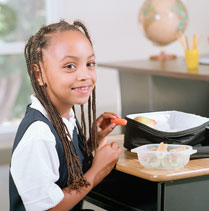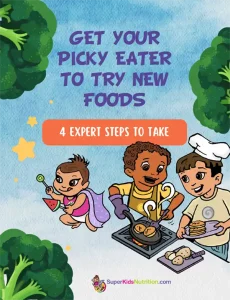
Most kids who eat lunch at school participate in the National School Lunch Program (NSLP). According to recently released statistics, the NSLP served over 31 million lunches in 2008.
The National School Lunch Program provides US kids with needed nutrients
That’s a lot of lunches! And that’s a lot of students. Any school that participates in the NSLP receives cash subsidies and donated commodities (foods) from the United States Department of Agriculture (USDA). Schools participating in the NSLP must meet the 2005 Dietary Guidelines that require that lunches have no more than 30% of calories from fat and less than 10% from saturated fat. School lunches must also provide one-third of the Recommended Dietary Allowances of protein, vitamins A and C, calcium, iron, and calories.
School lunch can make a difference
With obesity among our nation’s youth growing at an alarmingly high rate, school lunch is one way we can positively influence our youth. The most recent data shows that the prevalence of obesity has increased dramatically in the years 1976-1980 to 2011-2012:
- Kids ages 6-11 have seen a rise from a 6.5% obesity rate to 17.7%
- Kids ages 12-19 have seen a rise from a 5.0% obesity rate to 20.5%
So what do all of these numbers really mean for parents, educators and healthcare providers? Childhood obesity has numerous health-related consequences. Weight-related problems in children can contribute to high cholesterol, asthma, Type 2 diabetes, sleep disorders, and social discrimination, to name a few.
With so many children receiving their meals through the school lunch program, it is a great place to start having a positive impact on combating childhood obesity.
We can take advantage of this very large and captive student body by:
- Serving fresh, healthy, nutrient-dense foods that have lots of vitamins and minerals with fewer calories.
- Incorporating nutrition education across the curriculum, thus connecting the farm to the table so our children understand where food comes from, and the health and environmental benefits of eating locally grown and produced foods.
- Encouraging schools to include physical activity into their school day every day. Many of our nation’s schools have cut back on physical education classes to save money and to devote more time to mandated testing in reading and math.
What are some ways you can help your school lunch program?
- Get involved in the PTA and help organize a Farm-to-School program which has been growing in popularity. This could be a great opportunity to talk to your child’s school to see how you can help make this happen.
- Do a healthy fundraiser to get funds for health promotions
- Provide posters, images and marketing strategies that promote healthful choices with fresh fruit and vegetable and whole grain focus.
By now you should be asking yourself, “What do we need to change?” Read, “School Lunch Program: Food for Thought,” for more information.












